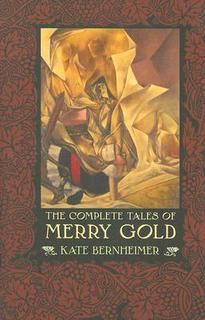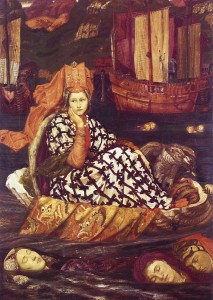 Given my interest in adapting fairy tales, studying Kate Bernheimer’s The Complete Tales of Merry Gold is a perfect choice. Bernheimer’s novel—along with her first novel, The Complete Tales of Ketzia Gold, and her third, The Complete Tales of Lucy Gold —uses German, Russian, and Yiddish fairy tales, occasionally by reproducing them in their entirety, but most frequently by way of contemporizing the tales and making them part of the narrative, although not always in clear or expected ways. Bernheimer’s approach to fairy-tale adaptation is more postmodern or experimental than mine, but an analysis of her technique has benefitted my own work. Warning: Spoilers to follow.
Given my interest in adapting fairy tales, studying Kate Bernheimer’s The Complete Tales of Merry Gold is a perfect choice. Bernheimer’s novel—along with her first novel, The Complete Tales of Ketzia Gold, and her third, The Complete Tales of Lucy Gold —uses German, Russian, and Yiddish fairy tales, occasionally by reproducing them in their entirety, but most frequently by way of contemporizing the tales and making them part of the narrative, although not always in clear or expected ways. Bernheimer’s approach to fairy-tale adaptation is more postmodern or experimental than mine, but an analysis of her technique has benefitted my own work. Warning: Spoilers to follow.
Bernheimer structures The Complete Tales of Merry Gold with three types of chapters—a first-person narrator (27 chapters), a third-person narrator (11 chapters), and actual fairy tales with one modified ballad (6 chapters). The third-person chapters didn’t have any fairy tale allusions (direct or otherwise) that I could find, so I’ll focus my examination on first-person and tale chapters.
The tale chapters are straightforward presentations of the original tales through which Bernheimer comments or reflects on the larger narrative. Bernheimer uses in this fashion three German tales (“The Crumbs on the Table,” “The Stolen Pennies,” and “The Louse and the Flea”), one Russian (“The Bladder, the Straw, and the Shoe”), and one Yiddish (“Upon Me”). The sixth such chapter is a modest adaptation of the Yiddish “The Ballad of the Faithful Wife” (somewhat shortened and including names from the main narrative). Some of the tales offer morals to complement Merry’s story: In “Upon Me,” the noblewoman who tries to punish an old woman by poisoning some bread is instead the one who suffers as when her own son eats the poisoned bread. The noblewoman’s malicious actions come back to torment her, as do Merry’s: Merry is alone, without friends or family, because of her past cruelties and other erratic, self-destructive behavior (although part of Merry’s problems are psychological—she spent some time in a hospital undergoing shock treatment—no one seems to treat her sympathetically because of her mental illness, nor does she offer herself any sympathy, even in this lucid period). Similarly, “The Bladder, the Straw, and the Shoe” is a story about a bladder who convinces a blade of straw and a shoe to cross the river without its help. The straw stretches across the river, and as the shoe crosses the straw breaks and the shoe drowns; the bladder laughs until it explodes. Eventually the bladder’s deliberate meanness catches up with it, and Merry feels that everything she’s done has brought her to this lonely place she’s in now.
The other three tales offer a reflection of or insight into the main narrative. “The Crumbs on the Table,” about a rooster who convinces some chickens into eating breadcrumbs although they know they’ll get in trouble (and who is quite pleased with himself when the chickens do indeed get into trouble), doesn’t comment as directly about the narrative as do the tales discussed in the previous paragraph, but it suggests that Merry gets into trouble doing exactly what she knows she ought not to do—being mean, drinking too much, distancing herself from others. “Crumbs” doesn’t offer any direct moral, just commentary. The next tale, “The Stolen Pennies,” follows a chapter in which Merry’s friend Semyon dies; the tale deals with a dead child who returns as a ghost to reclaim pennies he was supposed to in life give to the poor but instead hid under the floorboards, and once those pennies are given to the poor then the ghost disappears. Here perhaps Bernheimer wants us to read into the ghost’s presence—who cannot rest until his guilt is assuaged—Merry’s own guilt over the death of Semyon, particularly in respect to how she treats him before he dies. The last tale in the novel, “The Louse and the Flea,” is a cumulative story along the lines of “The House that Jack Built,” but at the end of the tale the louse, the flea, the door, the broom, the cart, the rubbish, the tree, and the girl are all drowned by the gushing spring. In the last line of the previous chapter, Merry refers to herself as “a louse of a young girl” (142), an obvious repetition, but the ending of “The Louse and the Flea” is more indicative of Merry’s assessment of her state of affairs, where her life has swept by without her being able to stop it, where indeed the girl herself has washed away. Merry tells us earlier, “I’ve wasted so much of my life. I hate myself” (124); perhaps the “The Louse and the Flea” is not a reflection but a wish from Merry, to be washed away.
The first-person chapters were of particular interest to me, as I’ve been thinking lately about how to be less literal in my adaptation of fairy tale plots. Bernheimer introduces the fairy tales into Merry’s narration in a number of ways, sometimes with a modernized version of the plot, sometimes with the inclusion of specific elements of the source tale but not the full plot itself. It’s worth noting, however, that Bernheimer sets up Merry as an unreliable narrator, owing to her (somewhat ambiguous) mental illness and (former) alcoholism. While occasionally the source tales have no magical elements and thus allow for smoother direct adaptation, the tales that do include magic are presented as part of Merry’s perspective of reality, which is off-kilter.
Bernheimer draws on fairy tales clearly in fourteen of the twenty-seven first-person chapters, but my discussion will be limited to the second chapter of Bernheimer’s novel, titled “The Star Nickels.” Bernheimer uses as her source material the German tale “The Star-Money” about a poor pious girl who has nothing but her clothes and some bread. She meets a hungry man and gives him her bread, then a man with a cold head and gives him her hood, and finally a series of freezing children to whom she disperses the rest of her clothes. Naked and alone, she stands in a field and the stars rain down money upon her and she magically receives a new shirt of the finest linen. The girl then “put[s] the money into it, and was rich all the days of her life” (The Complete Grimm’s Tales, trans. Margaret Hunt, rev. James Stem. Pantheon, 1972. 654). In Chapter Two, Merry begins by telling the reader, “I’m going to tell you something, so listen. Long ago I reached the end of my luck. Then I began to drink vodka” (19), invoking a traditional oral storytelling opening coupled with a modern sensibility (the vodka, Merry’s drink of choice). Merry uses this opening in other chapters, and sometimes even “Once upon a time.” The first part of the chapter relates Merry’s state of affairs—she’s alone, poor, but unwilling to ask her parents for help. Every night she goes to a café and two men give her coffee and a roll. She lives in a seedy building where she pays her rent either by coins she finds or by allowing the manager to take pictures of her, a strange alternative given what one might expect:
The camera captured just shadows and suggestions of movement. These dark pieces of me seemed to please him. It is good because that was all there was to be given. And he took. He took from me. And I gave. (20)
Despite her down-and-out life, Merry seems to have a kind of fairy-tale luck. She has no job, but hasn’t needed to turn to something sordid to make ends meet; men give her food and coffee daily, and even the arrangement with the manager is nothing to Merry as she reveals nothing discernable of herself to the camera. Merry’s “luck” may well be just a by-product of her mental illness, as soon she begins to hear pigeons talking to each other about her, or “realize that inside their exclamations [of people in the neighborhood yelling and shouting] was a message for me” (21). It’s at the end of the chapter that Bernheimer introduces the German tale, but at that point the tale does not seem intrusive, given that Merry’s life feels surreal and dislocated. On a particularly cold night—“…the coldest night I had ever known. Everything was dead, iced in the freezer of buildings, vaporized into thin slices of sky” (22)—Merry meets an angry (rather than hungry) man and gives him her roll and coffee. She meets a child who says, “My head is not thawing,” to which Merry responds that hers isn’t either (22) and then gives the child her jacket. Then she meets a second child, who’s naked and whom she dresses in her pajamas. Merry goes down to the river, submerges herself, and then the stars become nickels, which Merry grabs up. When Merry returns home she dreams “of birds that flew in glass coffins and children who flew inside birds. Everything beating” (23). Clearly this chapter illustrates Merry’s mental illness in its overall surreal quality, and by the time Bernheimer introduces her fairy tale source material the reader doesn’t distinguish between it and what has come earlier. The star-nickels read as another delusion of Merry’s.
By the end of the novel—when, for example, Merry recalls a childhood adventure where she and her sister go down a well and are threatened by a water-nixie who chases them but is deterred by common fairy tale tricks, like thrown grass that becomes a hill of thorns or a thrown comb that becomes a hill of teeth—Bernheimer’s fairy tale source material doesn’t stand out in sharp contrast to reality. The water-nixie story, although from a period of her life when Merry wasn’t mentally ill, doesn’t ask us to wonder how or why; the reader has been primed to accept the surreality, even if it’s not a factor of mental illness. What Bernheimer does here and elsewhere is to incorporate her source material so smoothly with Merry’s surreality that Merry’s life feels like a tragic fairy tale itself, with fact and fancy indistinguishable.





